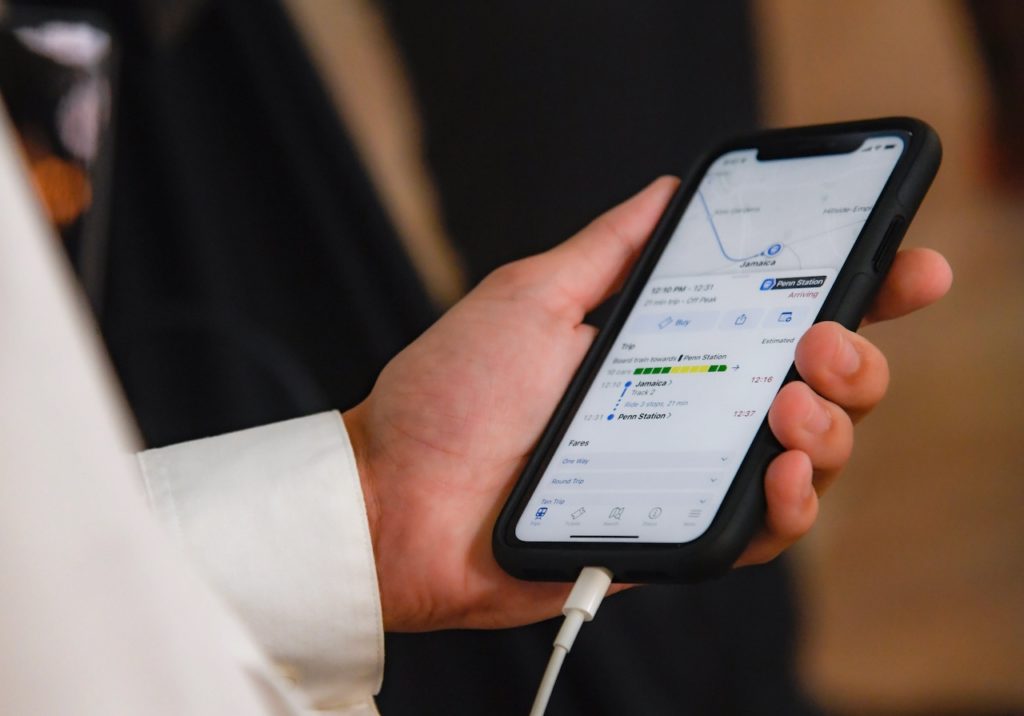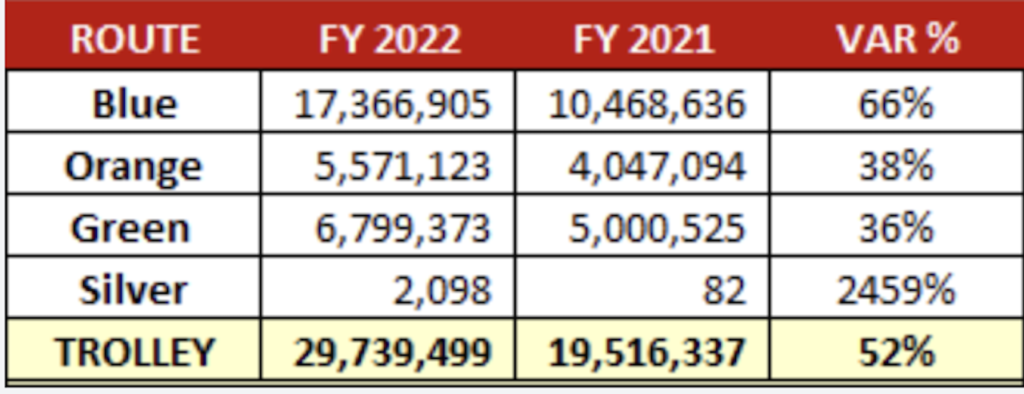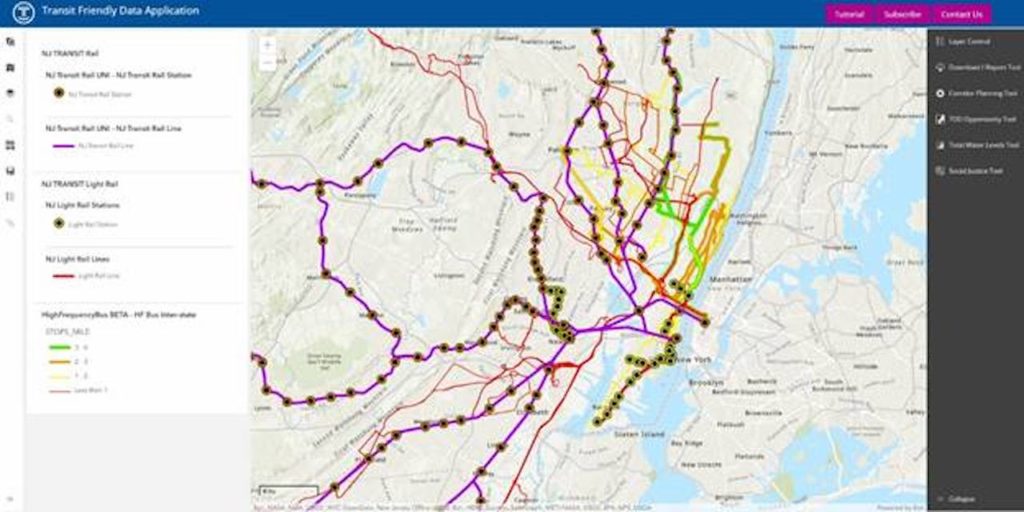
Transit Briefs: SunRail, NY MTA, MTS, NJ Transit, SMART
Written by Carolina Worrell, Senior Editor
Icomera has been selected to provide digital system upgrade to SunRail in Central Florida.
SunRail selects Icomera to provide digital system upgrade in Central Florida. Also, the Metropolitan Transportation Authority (MTA) launches one-stop rail app combining Long Island Rail Road (LIRR) and Metro-North Railroad trip planning and ticket purchasing; the San Diego Metropolitan Transit System’s (MTS) Fiscal Year 2022 (FY22) report reveals ridership has climbed nearly 50% compared to FY21; NJ Transit rolls out upgraded application for transportation and land use planning; and Sonoma–Marin Area Rail Transit (SMART) extends reduced fares, suspension of parking fees at SMART parking lots through June 30, 2023.
SunRail
As SunRail’s end-to-end solutions partner, Icomera will replace the existing legacy Wi-Fi system with industry-leading technology aboard 22 railcars, the company recently announced.
Once onboard, riders will connect their devices to the SSID and receive immediate access to a localized, web-based Captive Portal, Icomera says, giving passengers an always-online experience with the company’s proprietary network communications protocol SureWAN™. This, Icomera adds, will allow the onboard router to “intelligently connect to multiple cellular and other communications networks simultaneously to maximize data capacity, coverage, availability and redundancy.”
“Given the population growth of Central Florida, the availability of a high-quality Wi-Fi network aboard the SunRail fleet will support the flexibility in work hours and locations that the ‘work from home’ transition has introduced,” says Icomera Vice President of Sales and Marketing Gabriel J. Lopez-Bernal. “If a passenger’s commute can contribute towards their working day, and not disrupt it, then public transit will be the obvious and most effective modal choice.”
Beyond providing Passenger Wi-Fi, onboard systems will be consolidated, which, according to Icomera, reduces the infrastructure and minimizes the vendor ecosystem.
Icomera will serve as an extension of the team in every task–from onboard architecture design to delivery, and post-installation support for five years. The Icomera X-Series mobile access and application router was chosen as the central connectivity platform, providing managed Internet access for the Passenger Wi-Fi and serving as the virtual application host for other onboard systems.
Florida agencies continue to take advantage of new opportunities to connect the region and explore partnerships–this time with Insight Public Sector (Insight), a leading government intelligent transportation (IT) solution provider and group purchasing organization, says Icomera.
This digital transformation effort is a partnership between Insight, the Florida Department of Transportation (FDOT), which owns and operates the 61-mile commuter rail line and Icomera–allowing SunRail to “focus on meeting operational efficiency goals and streamlining the procurement process.” In 2020, Icomera partnered with Insight to better serve nationwide public sector customers, offer stability in pricing with the best guaranteed price, and address the unique challenges of limited resources and budgets.

MTA
MTA on Aug. 17 launched TrainTime–a new one-stop app for commuter rail customers in the region. The new app, which replaces MTA eTix, adds the functionality of previously separate TrainTime apps for LIRR and Metro-North, merging ticket purchasing, trip planning and real-time train location data.
Customers can access tickets purchased in eTix using their existing account information or create a new account using their Apple ID, Google account, or a text message, and can purchase tickets using Apple Pay. These new features, MTA says, complement features that are already popular with MTA app users, including a seat availability tracking and in-app chat with customer service.
According to the MTA, nearly 50,000 people downloaded the new app within the first 15 hours of its launch.
TrainTime now offers the following features:
Mobile Tickets on TrainTime: TrainTime is the first MTA app where ticket purchasing and trip planning live on the same app. Previously customers would have to use two apps to plan their trip—TrainTime to trip plan, and MTA eTix to purchase tickets.
Now, a customer can search for their train and purchase their ticket in seconds. When looking up their train, a “Buy” ticket button will appear on the screen. From there, a customer can log in using Apple, Google or their phone number and purchase their ticket. Once a ticket is purchased, customers will see the button show “Activate” as their departure time approaches, or “Wallet” if their trip is in the future.
Previous eTix users should use their existing account information to access tickets they have already purchased.
Real-Time Train Movement and Seat Availability Tracking: A core feature of the revamped app is the real-time train tracking map. In preparation for the app’s rollout, GPS sensors were installed on the entire LIRR and Metro-North fleet. When looking up a train, a customer can get the exact position of their train in real-time. Once a customer gets on the train, they can continue to track their movement.
The real-time train tracking is complemented by the popular seat availability tracker that the LIRR initially debuted in 2020. A customer can check the exact position of their train while on the train, while also knowing their exact car number and monitor that car’s capacity.
In-App Customer Service: In addition to the many social channels, customers can already go to for assistance, TrainTime meets riders where they are, providing in-app chat with customer service representatives for both railroads for the first time. Users can “Chat with us” on the “Status” tab.
Cross-Rail Trip Planning: The debut of TrainTime allows for a future feature of cross-rail trips when Grand Central Madison opens later this year.
A customer that will travel from Long Island to Metro-North region, and vice versa, will be able to plan their full trip and purchase their ticket without having to use multiple apps.
“For years the top request from customers has been to include a mobile ticketing option within TrainTime. We have delivered on that ask, while also providing great features,” said Metro-North President and LIRR Interim President Catherine Rinaldi. “Everything from seat availability tracking, reliable train-tracking and in-app support are all at a riders’ fingertips. I cannot thank our in-house development team enough for delivering on a project that riders from New Haven to Montauk can equally benefit from.”
MTS
According to its latest FY22 report, MTS ridership continues to climb, exceeding five million trips per month since March 2022. The report revealed an increase in ridership of 52% for Trolley and 41% for bus when compared to FY21. Between July 2021 to June 2022, Trolley ridership totaled 29.7 million trips compared to 19.5 million in the previous fiscal year; and bus ridership totaled 27.7 million trips compared to 19.6 million trips the year prior.
The COVID-19 pandemic provided a major challenge for transit agencies across the country as commute habits changed, including MTS where ridership plummeted to about 30% of normal levels in April 2020, the transit system said. According to MTS, which operates three Trolley lines and more than 100 bus routes in 10 cities and unincorporated areas of San Diego, ridership has since been able to recover to approximately 75% of pre-pandemic levels and reached approximately 200,000 weekday trips in the spring-summer of 2022.

According to MTS, the largest increase in Trolley ridership was seen on the UC San Diego Blue Line, which went up by 66%, jumping from 10.4 million rides the prior fiscal year to 17.4 million. In November 2021, MTS inaugurated an 11-mile Mid-Coast Trolley extension to UTC, allowing for the largest increase in ridership in one year for any line in the history of the transit system, MTS said.
Some of the largest increases in ridership were along routes that serve major school and employment centers, MTS says. The Rapid 201/202/204 routes all saw more than 300% jumps in ridership as UC San Diego students and staff returned to school in person.
Bus ridership also increased to more than one million trips each for the system’s highest performing bus routes, including Rapid 215 and Routes 7, 13 and 929, and serve areas of City Heights, Downtown, City College, South Bay and Grantville.
In May 2022, MTS, North County Transit District (NCTD) and San Diego Association of Governments (SANDAG) launched the Youth Opportunity Pass (YOP) Pilot program, which allows Youth 18 and under to ride free. Following the launch of YOP, MTS says, youth bus ridership jumped 34% in the first month of free transit (May vs April 2022), and remained high in June, even as schools were no longer in session (18% increase over April 2022).
NJ Transit
NJ Transit, in conjunction with the Alan M. Voorhees Transportation Center and the Office of Research Analytics at Rutgers University, announced on Aug. 17 that it has updated its Friendly Data Application, a digital tool that allows users to “map, report and download a range of land use, travel, public transit, demographic, and real estate development data throughout the NJ Transit network.”
According to NJ Transit, the application now features four new tools: Transit-Oriented Development (TOD) Opportunity; Corridor Planning; Total Water Level; and Social Justice.
Users can select and visualize various options in the Transit Friendly Data Application, based on their specific needs, NJ Transit says. The app, which, according to NJ Transit, is meant to be a resource for anyone interested in land-use and transportation analyses and is being marketed through presentations at professional conferences, regional events and soon-to-be online tutorials, features layers for demographics, environmental hazards, flooding scenarios, rehabilitation/redevelopment areas and travel modes. The transportation layer also includes data on all four NJ Transit modes: Access Link, bus, light rail, and rail.

The Transit Friendly Data Application is the latest tool in the agency’s Transit Friendly Planning Program toolbox, NJ Transit says, and is available at the following website: njtransit.com/transitfriendly. The innovative program, which has been providing planning assistance since 1999, is “dedicated to NJ Transit’s commitment to assisting communities with planning for transit-supportive land uses and transit-oriented development surrounding customer NJ Transit customer facilities,” the agency said.
The result has been the creation of countless consensus-based, transit-supportive land use vision plans that communities are using to guide development and redevelopment at existing or planned transit facilities, NJ Transit said.
Local transit-friendly vision plans have allowed the agency to “successfully demonstrate how statewide transportation investments can enhance the environment, create strong community centers, encourage private reinvestment in the local economy, and improve the quality of life,” according to NJ Transit
“This latest technology demonstrates how statewide transportation investments can enhance the environment, create strong community centers and encourage private investment in the local economy,” said New Jersey Department of Transportation (NJDOT) Commissioner and NJ Transit Board Chair Diane Gutierrez-Scaccetti. “This is a one-stop resource for transit-friendly planning and development.”
SMART
SMART announced on Aug. 17 that its Board of Directors passed a resolution extending reduced fares of more than 40% off, and the suspension of parking fees at SMART-owned and operated park-n-rides through June 30, 2023, citing the rising cost of living, inflation uncertainty and being able to provide “affordable and cost-effective alternatives to driving singly occupancy vehicles” as reasons for the extension.
The continued reduced fares include $1.50 per zone traveled, with seniors, youth, low-income, and passengers with disabilities receiving a 50% discount rate of $.75 for each zone traveled. SMART also offers a Weekend Day Pass providing unlimited rides for the entire day priced at $10.00 for adults and $5.00 for seniors, youth, passengers with disabilities, and low-income passengers.
For regular commuters, SMART’s 31-day pass (only available on Clipper) provides unlimited rides for $135 for adults and $67.50 for youth, seniors, passengers with disabilities, and low-income passengers.
“We believe that continuing our reduced fares is the right thing to do,” said SMART Board Chair David Rabbitt. “With high gas prices and economic uncertainty, we are committed to playing our part in helping North Bay communities manage their budgets and protecting the environment.”



